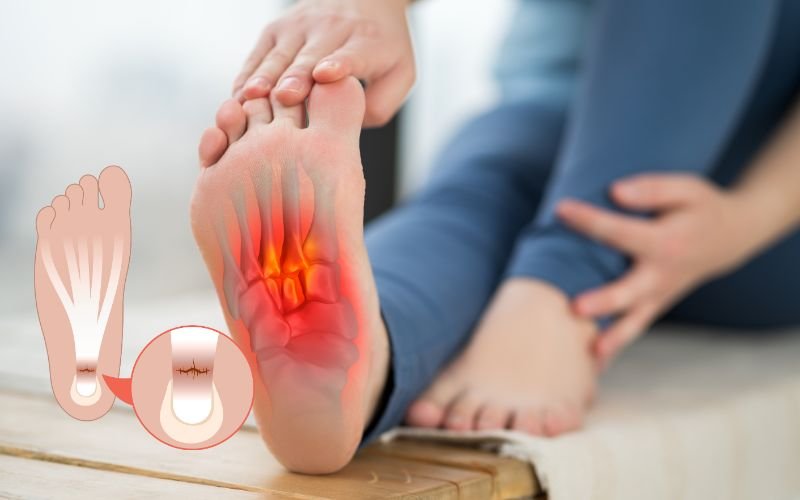Plantar fasciitis is a common foot problem that causes sharp pain in the heel and arch. It affects people of all ages, but especially those who stand or walk a lot during the day. Whether you are a teacher, runner, or someone who wears unsupportive shoes, this condition can slow you down. But here’s the good news — with the good orthopedic treatment in Delhi, plantar fasciitis can be cured easily. This article helps you understand its causes, symptoms and what treatments work fast especially under the care of an orthopedic specialist in Delhi
What is Plantar Fasciitis?
Plantar fasciitis is when the plantar fascia inflames which is the thick band that connects the heel and toes. It holds up the arch on the soles of your feet. If it is overstretched, it results in tiny tears that make the area sore and swollen. At a later stage, the suffering may not go away, even for a short period. Many individuals mix up plantar fasciitis and heel spurs, but plantar fasciitis is linked to soft tissue instead of bones
Plantar Fasciitis Symptoms
The most common sign is a stabbing pain at the bottom of your heel. It’s worse in the morning when you take your first steps. As you walk more, the pain might reduce, but it can return after standing or sitting for long periods. The pain can also feel worse after exercise, not during it. You might also notice tightness in your foot arch.
Plantar Fasciitis Causes
This condition usually comes from overuse or strain. The plantar fascia is meant to absorb stress, but too much pressure can damage it. Key causes include:
- Standing for long hours
- Running or jogging on hard surfaces
- Wearing flat or worn-out shoes
- Being overweight, which adds pressure to the foot
- Having high arches or flat feet
- Tight calf muscles or Achilles tendon
Who Is At Risk?
Plantar fasciitis affects both men and women, but middle-aged adults are most at risk. Athletes, soldiers, teachers, retail workers, and factory workers also often face this condition. People with improper walking patterns or foot structure issues also face a higher risk.
How to Cure Plantar Fasciitis Quickly with treatment in Delhi?
Fast relief depends on early treatment, rest, and medical advice. Here’s a list of proven ways to reduce pain and promote healing:
1. Rest and Reduce Activity
Cut down on activities that put pressure on your feet. If your job demands standing, take short breaks to sit down. Avoid running or jumping until the pain goes down. Rest is the first step in curing plantar fasciitis.
2. Ice Therapy
Ice helps reduce swelling and pain. Wrap a cold pack or ice in a towel and apply it to your heel for 15–20 minutes, several times a day. You can also try rolling a frozen water bottle under your foot.
3. Plantar Fasciitis Exercises
Stretching the plantar fascia, Achilles tendon, and calf muscles can help. Simple exercises like:
- Towel stretch
- Calf stretch on a wall
- Toe curls using a towel
- Plantar fascia stretch (pulling your toes toward you while sitting)
These should be done daily for best results. A physical therapist can guide you through the right stretches.
4. Use Supportive Footwear
Avoid walking barefoot, even at home. Wear shoes with arch support and cushioned soles. Choose the best footwear for plantar fasciitis that reduces heel impact. If needed, use orthotic inserts or heel cups.
5. Plantar Fasciitis Home Treatment
Try massaging your feet using a tennis ball or rolling pin. Elevating your feet at night or using a foot brace may also help. Keep your weight in check to reduce stress on the feet. Simple changes at home can prevent symptoms from getting worse.
6. Medication for Pain Relief
Over-the-counter anti-inflammatory drugs like ibuprofen or naproxen can reduce pain. But these are short-term fixes. Talk to a doctor before starting any medicine for plantar fasciitis if you have other health conditions.
7. Plantar Fasciitis Injection
If pain doesn’t go away, doctors may recommend corticosteroid injections. These reduce inflammation but must be used carefully. Repeated use may weaken the tissue, so they are given under expert supervision.
8. Physiotherapy for Recovery
Plantar fasciitis physiotherapy helps strengthen your foot muscles and improve flexibility. A Orthopedic bone hospital in Delhi can create a custom routine for you, combining stretches, massages, and ultrasound therapy.
9. Plantar Fasciitis Therapy Devices
Night splints keep your foot stretched while you sleep. Shockwave therapy may also help stimulate healing. Plantar fasciitis medical devices include braces, taping methods, and supportive insoles designed to reduce strain.
10. Plantar fasciitis surgery in Delhi
Surgery is rare and only considered when all other treatments fail. Plantar fasciitis surgery in Delhi involves releasing part of the plantar fascia. Healing takes a few weeks, and physical therapy is needed afterward. It’s done by experienced orthopedicians in Delhi.
Calcaneal Spur and Plantar Fasciitis
A calcaneal spur is a bony growth on the heel bone. Though different from plantar fasciitis, it often occurs along with it. The spur itself may not cause pain, but the inflammation in surrounding tissue can. Treatment methods are mostly the same and involve reducing stress on the heel.
Diagnostic Tools
Your orthopedic specialist may recommend an X-ray or MRI to rule out fractures or nerve problems. Plantar fasciitis x-ray helps rule out heel spurs or other bone conditions. Clinical examination and symptom history are often enough to make a diagnosis.
How to Prevent Recurrence?
Even after recovery, you must continue foot stretches, wear proper shoes, and avoid prolonged standing. Keep your weight in check and maintain foot health. Prevention is always better than cure.
Plantar Fasciitis in Hindi
Many patients in India look up “plantar fasciitis in Hindi” to better understand their condition. It’s called “प्लांटर फैसाइटिस” in Hindi, and knowing the term helps patients talk with local doctors more comfortably.
Why Choose an Orthopedic Specialist in Delhi?
Delhi has some of the best bone and joint care centers in India. An Bone specialist in Delhi understands local lifestyle issues and tailors your treatment accordingly. Whether it’s therapy, injections, or surgery, you get personalized care.
Bone Hospital in Delhi for Foot Pain
For expert care, choose a bone hospital in Delhi that offers modern diagnostic tools, in-house physiotherapy, and a dedicated foot and ankle department. Early treatment avoids complications and helps you return to normal life quickly.
The Role of Bone Clinic in Dwarka
If you’re looking for focused care, The Bone Clinic in Dwarka offers expert consultation, ortbopedic treatment, knee replacement, physiotherapy, and surgical treatment for plantar fasciitis. Their orthopedic team treats all foot and ankle disorders with advanced methods and personalized plans. The clinic focuses on quick recovery and long-term comfort for patients in Delhi NCR.
You can learn more about The Bone Clinic’s offerings and book an appointment by visiting their official website.
Plantar fasciitis can feel like a small issue, but it can take a toll on your daily life. Don’t ignore the pain. Start with home remedies and consult a trained orthopedic specialist in Delhi early. With proper treatment, the pain will fade, and your steps will feel lighter again.
Whether it’s therapy, medication, or surgery, remember: plantar fasciitis is curable — and you don’t have to walk through it alone.




